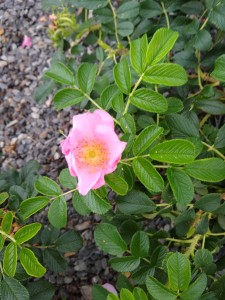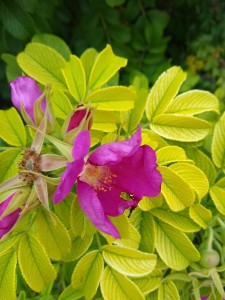Everyone has a garden dead zone. It can be a small area or a larger one where nothing seems to last very long. You buy plants over and over again that are labeled as “hardy” or “tough”, and install them with high hopes, only to watch helplessly as they struggle and die. Containers might work in the dead zone, but they do need extra attention, especially in hot weather or times of drought. Eventually you think about giving up and covering the area with mulch or gravel or some other neutral groundcover. After all, too much failure takes a toll on the gardener’s psyche.
 My dead zone was in the little garden bed that I planted at our Central New York summer cottage. I tried native plants, as well as species that I knew worked in a variety of challenging conditions. Though I am not a great lover of ornamental grasses, I even thought of putting in a nice clump of the indestructible Chinese silver grass or Miscanthus sinensis. Most of all, I despaired of ever finding a plant strong enough to resist very cold winters, clay soil and an abundance of neglect.
My dead zone was in the little garden bed that I planted at our Central New York summer cottage. I tried native plants, as well as species that I knew worked in a variety of challenging conditions. Though I am not a great lover of ornamental grasses, I even thought of putting in a nice clump of the indestructible Chinese silver grass or Miscanthus sinensis. Most of all, I despaired of ever finding a plant strong enough to resist very cold winters, clay soil and an abundance of neglect.
Just as I was about to pick up a one-gallon pot of miscanthus, I spotted a lonely rugosa rose at the back of a local nursery. It had no tag, but was easy to recognize by its wrinkled, dark green leaves and abundant prickles. It was not blooming, but the remnants of a recently departed blossom suggested that the rose was dark pink. It was also on sale for a ridiculously low price. Rugosas are hardy enough to survive on windswept New England beaches, so I thought it was worth a try in my dead zone.
I took it back to the cottage, hacked a large hole in the clay soil, amended the soil from the hole with an equal amount of compost and planted the rose. I tended it faithfully for the final five days of my vacation and then left it for ten months.
When Memorial Day Weekend rolled around the last spring, I was shocked to see that my rugosa rose was putting out new growth. By Labor Day it boasted even more new growth and was blooming, with a cluster of semi-double flowers in a lovely shade of dark, purplish-pink. Best of all, those blooms were as fragrant as any rose I have ever encountered. Most rugosa hybrids have a strong, spicy scent, with clove as the predominant note. My anonymous rugosa had a ravishing old rose scent. Only the prickles deterred me from cutting the entire cluster and bringing it into the cottage.
My rugosa not only survived but thrived for a year in the dead zone. That in itself is cause for a garden party. The stunning, fragrant blooms called for fireworks.
Rugosas are native to Eastern Asia and Japan, and, according to English garden designer and writer Dan Pearson, the toughness comes from the fact that the rose’s “natural domain is the salt-blasted sand dunes of Russia and Japan.” The plants were introduced into Europe in the 1830’s, charming Europeans in search of sturdy, fragrant roses. Eventually they made their way to the New World. The plants succeeded so well in New England and northern Ontario that they escaped from gardens and naturalized readily. The dune roses that you see on New England beaches, with hips as big as cherry tomatoes, are escaped rugosas.
Breeders could not resist the rugosas, and have produced many hybrids over the last century and a half. Most of them have the characteristic spicy fragrance, prickly stems, large hips, and bloom in shades ranging from white through dark red. I suspect that mine might be ‘Hansa’, a red variety introduced in the Netherlands in 1905. It resembles the blooms on my rose and is noted for strong fragrance.
Rugosas are great specimen plants, but also work well for privacy hedges. Though they are not fussy about soil and shrug off climatic extremes, they do require full sunlight. Some varieties will also do reasonably well in very light shade.
I am very fond of ‘Blanc Double de Coubert’, a hybrid rugosa with double white flowers, introduced in 1893 by a French breeder with a wonderful name–Charles Pierre Marie Cochet-Cochet. The spicy fragrance is very pronounced and the blossoms shine. Another popular rugosa is ‘Frau Dagmar Hastrup’, a light pink, single-flowered variety. If I can find the room in my home garden I will also try ‘Agnes’, a yellow Canadian rose, introduced in 1922. I love yellow roses and would have even more of them if they weren’t so susceptible to black spot. ‘Agnes’ might just fill that bill and add fragrance to the mix.
Good nurseries and garden centers often carry rugosa hybrids, though they are not always named varieties and are sometimes positioned behind or off to one side of the flashier roses. Look for the wrinkled leaves and prickles, which will be evident on even a non-blooming plant. If you opt for mail order, you can try Heirloom Roses, 24062 NE Riverside Dr., St. Paul, Oregon 97137; (800) 80-0465; www.heirloomroses.com.
